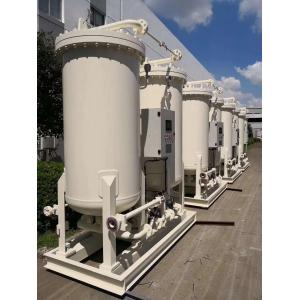

Add to Cart
Paper and Pulp industries for Oxy bleaching and delignification
with 15 bar on-site oxygen generator by VPSA technology
An oxygen generator is a device that separates oxygen from
compressed air using special selective adsorptive technology called
pressure swing adsorption (PSA). The compressed air used in the
oxygen generation process has a similar composition to ambient
environmental air with 21% oxygen and 78% nitrogen. The oxygen
contained in the compressed air is allowed to flow through a
zeolite molecular sieve which retains nitrogen resulting in high
purity oxygen at gas production outlets.
Operating Principles for a PSA Oxygen Generator
The pressure swing adsorption process for a PSA oxygen generator is
essentially the same as that of a nitrogen generator with one major
distinction. The adsorptive material inside its molecular sieve is
made of zeolite rather than carbon found in a nitrogen PSA device.
During a routine operation, compressed air channeled through the
oxygen generator will be separated into its component gases. The
zeolite molecular sieve will selectively adsorb nitrogen that meets
it while allowing high purity oxygen gas to flow onwards to a
product gas outlet.
A unique feature of zeolite that makes it ideal for an oxygen
generator is its ability to released retained nitrogen gas once the
pressure within the generator is eased. This makes it quite easy to
regenerate the medium for a further cycle of oxygen generation.
How Does an Oxygen Generator Work?
An oxygen generator using PSA technology utilizes the ability of
adsorbent zeolite material to separate a stream of compressed air
into its component gases. The pressure swing adsorption process to
produce high purity oxygen is a two-stage cycle that involves
simultaneous adsorption and desorption activities in two generation
towers.
Adsorption
The adsorption stage of oxygen generation uses an adsorptive tower
packed with molecular zeolite pellets that selectively retains
nitrogen while allowing oxygen to pass into a collecting tank as
product gas under pressure.
This process of selective adsorption will continue until the
adsorptive tower reaches its maximum saturation point at which the
zeolite sieve can no longer absorb more nitrogen gas.
Desorption
This second step in the PSA oxygen generation process is
essentially a reversal of the adsorption process. Once the
saturation point for a tower in the adsorptive phase is reached,
its function is altered. Regeneration of the zeolite material is by
rapidly depressurizing the cylinder to release absorbed nitrogen
gas into the atmosphere.
The entire PSA process is automated with a central regulatory unit
detecting oxygen and nitrogen gas saturation levels in both the
adsorption and desorption towers. The phase switch is done by
opening or closing the appropriate process valves and raising or
reducing the pressure within the zeolite packed cylinders.
Features and Benefits :
Turnkey solution
Fully automatic operation
High purity of gas outlet stability
Very competitive production costs
Evolving concept with one or more interconnected production lines
Integrated controller system with high definition color touch
screen
Ergonomic design for simple and economical maintenance
Durable performance thanks to reliable, tested and controlled
components
Low consumption - high efficiency molecular sieve
Technical datas
Purity : from 90 to 99.5% (DS-PSA models)
Flow : from 2 to 150Nm3/h
Inlet pressure : from 7.5 to 10 bar
Applications
Fish farming
Glass Industry
Healthcare / Veterinary
Metal Industry
Water Treatment
Vinification
| Model | Capacity | Purity | Outlet pressure | Inlet | Outlet | Dimensions | Weight |
| OSO5 | 5 |
|
| DN20 | DN10 | 1350*1200*1800 | 800 |
| OSO10 | 10 | DN25 | DN15 | 1800*1250*2200 | 1200 | ||
| OSO15 | 15 | DN25 | DN15 | 2100*1450*2200 | 1500 | ||
| OSO20 | 20 | DN40 | DN25 | 2300*1550*2450 | 1800 | ||
| OSO30 | 30 | DN40 | DN25 | 2450*1650*2550 | 1950 | ||
| OSO35 | 35 | DN50 | DN25 | 2650*1900*2550 | 2150 | ||
| OSO40 | 40 | DN50 | DN25 | 2800*2200*2600 | 2200 | ||
| OSO50 | 50 | DN50 | DN25 | 3100*2450*2700 | 2350 | ||
| OSO60 | 60 | DN65 | DN40 | 3300*2600*2900 | 2550 | ||
| OSO80 | 80 | DN80 | DN50 | 3500*2950*3100 | 3300 | ||
| OSO100 | 100 | DN80 | DN50 | 3850*3100*3300 | 4000 | ||
| OSO150 | 150 | DN100 | DN65 | 4100*3300*3450 | 5100 | ||
| OSO200 | 200 | DN125 | DN80 | 4600*3550*3500 | 6200 | ||
| OSO250 | 250 | DN125 | DN80 | 5500*3900*3900 | 8500 | ||
| OSO300 | 300 | DN150 | DN100 | 5800*4200*3980 | 10500 |
Design reference :
Compressed air inlet pressure 7.5 bar(g)/108 psi(g)
Air quality 1.4.1 according to ISO 8573-1:2010
Oxygen outlet pressure 2-4 bar(g)/58psi(g)
Oxygen quality 1.2.1 according to ISO 8573-1:2010.
Designed working temperature max 50 ℃
Dew point at Oxygen outlet - 50 ℃
Notes:
Following request of oxygen generator will be customized :
Oxygen outlet pressure >4 bar(g)/58 psi(g)
Filling cylinders 150 bar(g)/200 bar(g)/300 bar(g)
Dew point < - 50 ℃
Movable/containerized , plug and play
Other special requirements as per site conditions
